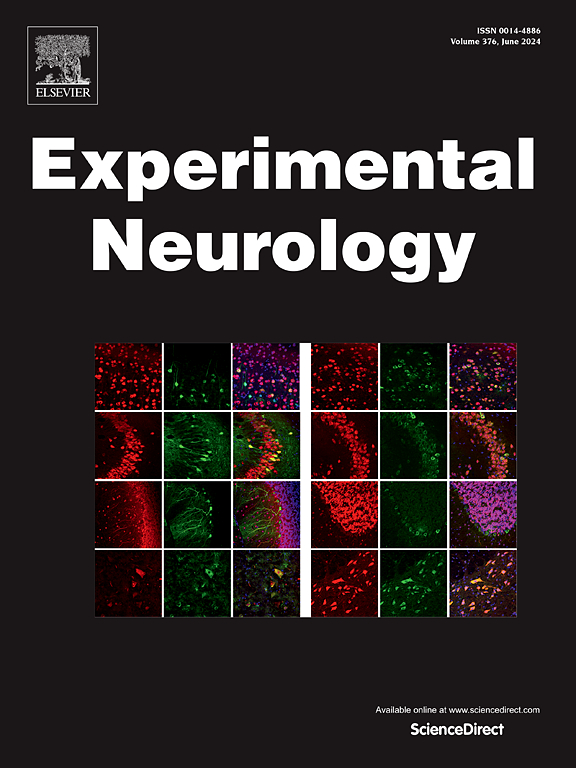Astragaloside IV confers neuroprotection against radiation-induced neuronal senescence via the ERK pathway
IF 4.6
2区 医学
Q1 NEUROSCIENCES
引用次数: 0
Abstract
Various factors and mechanisms, including radiation, initiate cellular senescence and are concurrent with the progression of various neurodegenerative diseases. Radiation-induced chromosomal aberrations and DNA integrity damage impact the processes of cellular growth, maturation, and aging. Astragaloside IV (AS-IV) has been documented to display significant neuroprotective effects on inflammation, oxidative stress, and cellular apoptosis; however, the precise neuroprotective mechanism of AS-IV against neuronal aging remains unclear. In this study, radiation-induced senescence models in C57BL/6 mice, PC12 cells, and primary neuronal cells were established. SA-β-gal histochemistry, flow cytometric analysis, immunofluorescence technique, and Western blotting analysis were employed to investigate the underlying mechanism of AS-IV in mitigating the aging of the brain cells caused by exposure to radiation. Our findings revealed that radiation exposure may activate the ERK pathway, leading to an increase in SA-β-gal-positive cells, elevated p21 levels, and the arrest of neuronal cells in the G1/S phase. However, AS-IV has been observed to mitigate the radiation-driven proliferation of senescent cells, by downregulating p-ERK and CDK2 expression and upregulating p21 and RB expression in treatment, thereby alleviating the aging and cognitive impairment caused by radiation. Additionally, evidence of U0126 treatment further supports these findings. In summary, our study showed that AS-IV could protect mice from radiation-induced cognitive impairment and reduce cellular senescence by regulating the ERK pathway.
黄芪甲苷通过ERK通路对辐射诱导的神经元衰老具有神经保护作用。
包括辐射在内的各种因素和机制引发细胞衰老,并与各种神经退行性疾病的进展同时发生。辐射诱导的染色体畸变和DNA完整性损伤影响细胞生长、成熟和衰老的过程。黄芪甲苷(AS-IV)已被证明对炎症、氧化应激和细胞凋亡具有显著的神经保护作用;然而,AS-IV抗神经元衰老的确切神经保护机制尚不清楚。本研究建立了C57BL/6小鼠、PC12细胞和原代神经元细胞的辐射致衰老模型。采用SA-β-gal组织化学、流式细胞术、免疫荧光技术、Western blotting分析等方法探讨AS-IV减轻辐射致脑细胞老化的作用机制。我们的研究结果表明,辐射暴露可能激活ERK通路,导致SA-β-gal阳性细胞增加,p21水平升高,神经元细胞在G1/S期停滞。然而,AS-IV已被观察到通过在治疗中下调p-ERK和CDK2的表达,上调p21和RB的表达,从而减轻辐射引起的衰老和认知障碍,从而减轻辐射驱动的衰老细胞增殖。此外,U0126治疗的证据进一步支持了这些发现。综上所述,我们的研究表明,AS-IV可以通过调节ERK通路,保护小鼠免受辐射诱导的认知障碍,并减缓细胞衰老。
本文章由计算机程序翻译,如有差异,请以英文原文为准。
求助全文
约1分钟内获得全文
求助全文
来源期刊

Experimental Neurology
医学-神经科学
CiteScore
10.10
自引率
3.80%
发文量
258
审稿时长
42 days
期刊介绍:
Experimental Neurology, a Journal of Neuroscience Research, publishes original research in neuroscience with a particular emphasis on novel findings in neural development, regeneration, plasticity and transplantation. The journal has focused on research concerning basic mechanisms underlying neurological disorders.
文献相关原料
公司名称
产品信息
索莱宝
β-actin
索莱宝
PMSF
索莱宝
propidium iodide
 求助内容:
求助内容: 应助结果提醒方式:
应助结果提醒方式:


